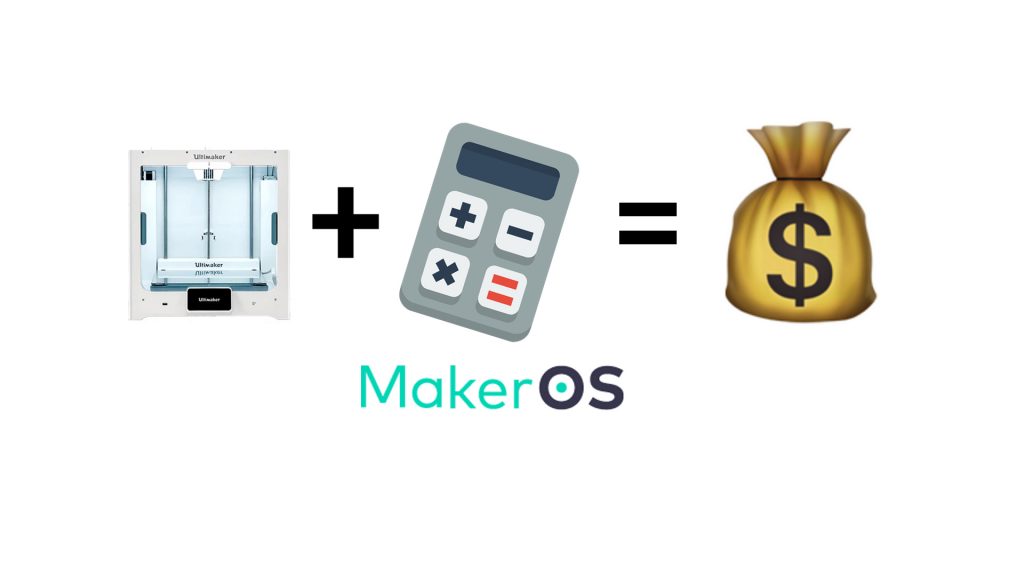By Mike Moceri, founder and CEO, MakerOS
Last month, I talked about how early on in my career I undersold my 3D printing services during one particular job and lost out on a significant amount of revenue. It wasn’t long after I realized that I wasn’t the only one who was experiencing this issue in my industry. I built a company to address the issue and together with my team, we developed a holistic methodology on how to accurately price 3D printing projects that accounts for all aspects of a 3D printing and digital fabrication business.
Today, I’m taking it a step further and will talk about how our proven methodology works for FFF/FDM 3D printing with PLA material, but you can apply these principles to any other material you fabricate with. Specifically, I’ll share with you the specific inputs you’ll need in order to effectively implement our methodology.
Regardless of how big your operation is, there are specific bits of information that you need on hand in order for us to calculate your costs. Here’s what you need to know:
Material
Let’s begin by calculating your total cost per gram. To do that, you need to know the following.
What is your purchase unit? If you’re using a desktop machine, you’re more than likely buying it by the kilogram for your purchase unit. But it may be sold by the gram, by the pound, or by the cubic inch, so make sure you double-check and have that information handy.
What is the unit cost for your material? If you’re purchasing your material from Amazon or some other reputable reseller, you’ll typically pay between $15 to $45 for a 1-kilogram spool of PLA.
What is your material density in grams per cubic centimeter? Typically the density for PLA is 1.24 grams per cubic centimeter. Refer to the material data sheet provided by the manufacturer.
With those values, you can calculate a total cost per gram.

Machine
Next, we need to understand a few things about your FFF/FDM machine.
What is the principle cost of your machine? If you’re using a midgrade, prosumer level machine, you’re probably in the $5K to $6K range, but it may be as much as $10K.
What is your machine’s lifetime hours? Specifically, you’ll want to know what the usage time is for your machine. This may seem hard to determine but in reality, it’s not hard to find out. Depending on who the manufacturer is, there should be some life testing data available to you. That may be in the manual or you may need to reach out to the manufacturer. Alternatively, you can estimate this number based on experience or when you expect to replace it. In my personal experience, I have scrapped FFF machines approaching 6,000 hours over a 5 year period to either replace with a new model or because the machine wasn’t worth maintaining anymore.
What’s your maintenance and service cost for your machine, per year? With a desktop prosumer machine, you’re likely to spend at least 40 hours per year just maintaining the machine along with additional consumables – how much do that spent time and materials cost you? Alternatively, you may have purchased a service package from the OEM or reseller, which for the example machine mentioned above, can range between $500 to $1,000 per year.
With all of these inputs, we can calculate the hourly depreciation and maintenance costs for the machine.
Fabricated Material & Deposition Rate
How long does it take you to fabricate 1 cubic centimeter of material? Also known as the “material deposition rate”, this is one of the most important factors for our calculations. How long does it take to fabricate one cubic centimeter of PLA? There are several options on how you can calculate this. You can slice a 10x10x10mm cube at 100% density with your typical settings and refer to the output values. Another way, which is much more accurate, is to take your phone or stopwatch and time the print from the very moment it starts laying down material to the moment that the machine completes the print.
Of course, depending on geometry, firmware, and other factors, the average material deposition rate will vary. Our goal here is to get to an acceptable baseline average. If you want to be even more precise, then I suggest timing 10 print jobs with varying geometries and weighing the final prints. Time in minutes divided by the average weight of the prints in grams will calculate your average material deposition rate and determine how quickly you can deposit 1 cubic centimeter of material.
With this information, and with what we already know, you can find how much material you use in an hour and ultimately how much that costs you per hour.
Facility, Human Time, and Software/Services
Finally, let’s incorporate the remaining ancillary data points to determine your costs.
What is your rent and what are your monthly utilities for your space? This is your facility cost.
How many people are required to operate the machine and what is their hourly rate? How long does it take them or you to set up and tear down a machine after a print job? This is your human costs per print job.
How much do you pay for your CAD software, your slicer, and your CAM or ERP system?
How about your accounting software, your email and internet providers, or any other software you’re using on a daily basis? (quick plug: these are the costs that you’ll consolidate and save on when you user MakerOS). When combined and divided by the total working hours in a year, you get your calculated costs which are a comprehensive hourly cost to your business for every print job with your FDM/FFF machine. So take a second and consider how long your average job takes to print. Maybe it’s 12 to 18 hours? Up to 48 hours for bigger jobs? You can get a sense of just how big that cost is to you.
What is the true cost of printing with FFF/FDM?
Now let’s calculate the cost to fabricate that entire 1-kilogram spool of PLA. Determine an average number for how many print jobs you can get from all that material, and multiply that by your human costs. When combined with your other calculated costs, you get a total cost to fabricate all of your material, and I guarantee that you will be shocked at how large this number is.
If our average deposition rate is 12.5g/hr, then we can assume that it will take roughly 80 hours to fabricate the entire spool. If on average your prints are 100g per print job, then on average you can fit roughly 10 print jobs within a spool. Multiply your total hourly costs by the amount of hours that spool will last along with the human cost on the average 10 print jobs per spool.
Don’t feel discouraged if your cost to fabricate 1 spool is above $500. That is totally normal and depending on your rent and machine, can exceed even $1,000.
What should you charge for FFF/FDM 3D Printing?
Ok, so what should you charge? What’s your margin? That answer varies depending on who your clients are and what your projects are for. For example, if your clients are in the consumer electronic industry, you probably should charge upwards of an 80%-200% markup. But don’t be hesitant to go even further. For many of you, your time and work are more valuable than you think.
Now you have all of these inputs, you can find a minimum hour price for each hour of printing time. Add your total hourly cost, your human time, and your markup, and together you get your price.
Free 3D Printing Pricing Calculator
To make this easy for you, we’ve created a 3D printing pricing calculator where you can enter all of these inputs to find your minimum hourly price. We also offer a much more detailed pricing guide specifically for FDM/FFF printing to guide you through this exercise. If you’re more of a visual learner, check out our video tutorial.
Still have questions specific to you and your business? Speak directly with me and let’s talk shop. I offer complimentary consultations when you book a demo of MakerOS.
MakerOS is a software platform for 3D printing and digital fabrication companies to better collaborate with their clients throughout the entire lifecycle of the project. The tools include a “Public Autoquoter” which incorporates elements of our pricing calculator and helps set up the project for success for both you and your client. Contact us to learn more.

About Mike Moceri
Mike has deep experience in manufacturing, design, and software. He’s personally quoted thousands of projects, produced hundreds of thousands of individual parts, and continually works with professional services around the world that offer Additive Manufacturing at MakerOS. In 2013, he co-founded the world’s first 3D printing retail service bureau in Chicago. In 2014 he founded Manulith, a 3D printing, and product design agency, where his clientele included Fortune 500 companies within the aerospace, automotive, and medical industries. Mike is also a mentor at Stanley+Techstars Additive Manufacturing Accelerator, a mentor at WeWork Labs in NYC, and formerly a mentor at TechTown Detroit. He’s previously been featured on MSN, Make Magazine, NBC, and the Encyclopedia Britannica. D-Business Magazine called him the “Face of 3D printing.”


